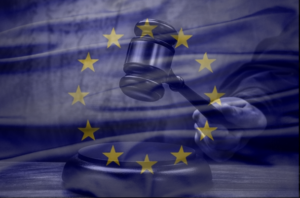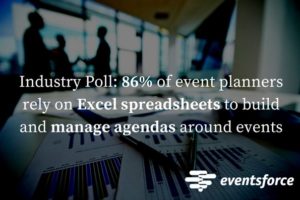In this month’s round-up of top event tech news, we look at live chat technology and the impact it can have on boosting ticket sales on your event websites. We also bring some important updates from Facebook which change the way your event posts appear on news feeds, as well as some great input from well-known industry experts on the kind of event technology we need to look at in 2018. Finally, we look at what steps event planners need to start taking now to get ready for the upcoming GDPR, along with some new Smart badge technology that makes networking at events a lot easier for everyone.
Have a look at what you may have missed:
Event MB: How Live Chat Technology Can Help Sell 45% More Event Tickets
Need to sell more event tickets? It might be as easy as adding a simple feature to your event website. According to this piece from Event MB, Live Chat allows your visitors to get immediate answers on any questions they may have around your event, without the need for a phone call or email. We know how purchasing an event ticket can be largely driven by emotion, which means if your potential attendee doesn’t get the answer they need at that moment, they may reconsider and look elsewhere. With live chat, however, people can get answers to their questions while they are still excited and interested in the event. Not only that, the tool can also help people through the registration process and provide a more personalised experience, as well as reduce your own admin expenses like dealing with queries. Read more.
Making Your Event Staff Aware of GDPR is Just the First Step
Hot of the press is the news that an NGO aimed at helping EU citizens fight for privacy rights under GDPR has launched this week, making the risks of non-compliance all the more real for organisations collecting and processing the information of people in the EU. This article from C&IT looks at the impact of the new legislation on the events industry and how planners need to take some crucial steps to ensure their event operations don’t put their own organisations at risk.
Top of the list is making sure everyone on the events team understands what GDPR means, the risks of non-compliance, as well as the changes that need to be made in the way you collect, store and share the personal information of people coming to your events. For example, they need to understand you’ll no longer be able to share delegate lists with hotels and venues without having the right kind of consent. You also need to run a data audit to assess what personal data you already hold in the tech systems you use around events, where that data came from and whether or not you have the right kind of consent in using that data. Other steps include updating consent boxes on forms, putting processes in place that address your attendees’ new rights, keeping data safe and preparing for a potential data breach. Read more.
Get your FREE eBook: ‘The Event Planner’s Guide to GDPR Compliance’, and learn what impact Europe’s new data protection regulation will have on event marketing, data management and event technology – as well as what steps event planners need to take now to get ready for the May 2018 deadline.
BBC News: Facebook Plans Major Changes to News Feeds
Facebook is to change how its news feed works, making posts from businesses, brands, media (and events!) a lot less prominent. Instead, content that sparks conversations among family and friends who use the site will be emphasised. In many ways this is Facebook getting back to its roots, making news feed more about what friends are creating and thinking, rather than articles they have shared. What this means for event marketers, however, is that they may start seeing the popularity of their posts go down as a result – which isn’t great news for those that rely on news feeds for generating organic traffic. Have a look at this article here for more detailed information on how this announcement affects marketers.
Facebook’s latest step in its on-going effort to fix its embattled news delivery offering also now involves prioritising local sources – so pushing local news offerings to the top of users’ feeds. The new feature announced this week will elevate news that’s clicked on by users in a tight geographic locale along with outlets based in that area. Content will also be prioritised as users follow or share stories from specific publications. Read more.
EventTech Talk: Ask the Experts – Top Event Technology Trends 2018
EventTech Talk recently spoke to some of our industry’s well-known editors, bloggers and tech experts to find out what application of event technology stood out in 2017 and what they think will be the next big thing over the coming year. It seems facial recognition technology will gain more popularity as it proved to be a viable and practical event check-in option for attendees over the past year. Another game changer is predicated to be attendee intelligence technology that tracks user behaviour and personalises interactions with individual participants.
Chatbots are another thing to watch out – being one of the most understandable applications of Artificial Intelligence (AI) in our industry. They have no learning curve and they’re platform agnostic – becoming more intelligent and useful as the technology matures. We’re also seeing a bigger push towards integration – and not just between the different systems used around events but with other back end solutions too. More and more organisations will start to integrate their event data with CRMs to help them better understand attendees and make it easier to track and attribute things like sales deals to events. Read more.
eBook: The Event Planner’s Guide to Data Integration
Event Industry News: 5 Things Event Profs Can Learn from CES 2018
The global Consumer Electronics Show took place in Las Vegas this month to bring us the latest in technology innovation, along with some weird and wonderful devices. Event Industry News has put together a nice piece that summarises the biggest announcements from the show and what impact they’ll have on the events industry. Aside from the usual suspects like AR, VR and drones, some highlights include wireless charging stations which allow attendees to charge their smartphones on the go and the increasing use of Android devices over iPhones. We also have voice-activated technology, electric cars and LG’s new roll-able TV! Read more.
Event Tech Brief: Smart Badges – Ready to Wear Networking
Placing your attendees in a room with instructions to ‘network’ is not a great way to produce meaningful interactions. Most people at conferences aren’t accomplished networkers. Even the pros still have to go through awkward introductions and questions only to discover that a conversation leads nowhere. Enter the world of smart badges. This article from Event Tech Brief looks at the Proxfinity smart badge which visually connects people at events who have communicated in advance their desire to discuss one or more specific topics.
How does it work? Attendees receive smart badges loaded with their contact information and responses to a pre-event survey of topics, at check-in. When one badge wearer comes within proximity of another who has indicated a mutual interest, the badges signal a match. In addition to sparking conversations, the badge also records the location of discussions (enabling a heat map) and dwell time. And because the devices exchange contact information (a post-event report of all connections made is available to wearers), participants can use them for lead tracking too. Read more.
If you would like to get similar monthly round-ups on all things event tech, along with some expert advice on how to make the most out of your technology investments, then please sign up to our weekly EventTech Talk Newsletter here.















